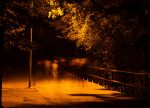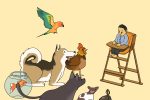If someone sees a bird while on a walk, how likely are they to know what type of bird it is? Beyond the task of species identification, an overwhelming amount of the general population doesn’t know much about the natural landscape they inhabit, and therefore lack awareness about the complex species profile of the birds around them. Biannual bird migrations in the spring and fall bring an astounding appreciation for the cyclical nature of life by virtue of fantastic displays of color and ingenuity throughout the Western Hemisphere.
The most spectacular features of a bird migration often occur in the dark of the night. There are still, however, over 4 billion bird species that earn most of their migration milage during the day, and those that do migrate at night often remain at “hotspots” during the day. The current fall bird migration began on Sept. 10 and will last until Nov. 30. The purpose of the bird migration for the migratory species throughout the United States and Canada is to cross the southern border of the U.S. and continue on into Mexico or further south.
The Nuts and Bolts
There are numerous factors in why a migratory bird may begin its migration. In order of importance, these include changes in daylight duration; a declining number of flowers, nectar and insects; instinct; an individual bird’s internal biological calendar and cooling weather conditions.
The Homing Instinct
As migratory birds travel to their “wintering” locations, they use their internal compass and map to demonstrate “a remarkable homing instinct.” A homing instinct is what gives birds the ability to journey to the same wintering grounds each year by memory.
The homing instinct of a juvenile bird begins with the bare bones of an innate and evolutionarily designed “knowledge of the direction and distance they should travel,” although their efforts are not aimed at a particular objective just yet. The birds will then develop a “winter range,” which then solidifies their biological promise to return to the same wintering grounds regardless of any disturbances during migration. A bird’s winter range is decided by the winter range of its group or relatives.
The Maps and Compasses
The internal map of a migratory bird helps the bird gauge their progress toward its homing or migration goal. There are several theories related to the internal maps of migratory bird species such as the “Nose Knows Theory” and the “Magnetic Map Theory.” The controversial Nose Knows Theory asserts that a migratory bird has an internal map of places that are unknown because they use an olfactory map.
The Magnetic Map Theory posits that a migratory bird may generate a partial map by using the Earth’s magnetic field for “a limited indication of the bird’s latitude.” In fact, the website All About Birds, which was created by the Cornell Lab of Ornithology, has an article titled “The Basics: How Birds Navigate When They Migrate” with a portion that reads, “There is some indication that homing pigeons have the sensitivity to detect even tiny changes in the strength of the magnetic field.” There is a lack of evidence for both theories and further explanation is needed to get a better picture of the mapping skills of birds.
The internal compass of a migratory bird is said to aid the bird’s flight by keeping the bird “on course” toward its goal. Conventional understanding agrees that migrating birds use several different compasses like the “Sun Compass,” the “Star Compass,” the “Magnetic Compass” and the “Sunset Cue.” It is speculated that migratory birds use several compass methods and “calibrate them against each other” with some species using “one type of compass as the primary navigational aid while others rely on a different primary system.”
The Sun Compass of a migratory bird is closely related to its circadian rhythm. The relationship between a migratory bird’s Sun Compass and circadian rhythm offers “a time compensation ability to make allowances for changes in the sun’s position over the course of a day,” or a shift in “migratory restlessness” as a response to a new positioning of the sun and the bird’s respective compass direction. The relationship also points to the results of homing studies that suggest pigeons “learn the sun’s path to use it in navigation” in a way that is reliant upon the time of day.
The Star Compass aids the many songbird species that travel at nighttime by offering something like a “genetically coded map of the stars.” It has been revealed through studies that the Star Compass does not entail the memorization of the star patterns themselves, but is instead “a learned north-south orientation from a rotational star system.”
The Magnetic Compass resolves the dilemma created by the fact that birds can detect the opposite poles of a compass but cannot distinguish between them. A migratory bird may detect the way the magnetic lines of force align toward the poles of the Earth to determine the northern direction relative to their orientation. A migratory bird may also “detect the dip in the lines of force as they approach the Earth” and thereby use the dip angle “to detect and make navigational decisions.” The Sun Cue is the “polarized light pattern” for understanding the “initial migratory flight directions.” The Sun Cue benefits migratory birds that are nocturnal migrants and begin traveling during and soon after sunset.
For birds that travel during the day, aspects of the natural landscape “such as mountain ranges, rivers, and lakes” inform their movements.
During the southward movement of migratory bird populations, they depend upon “hotspots,” or habitats to survive. Sometimes the migrating birds need to take a break or have a period of recovery; this is often referred to as a “fallout” among members of the overlapping avian biology, ornithology and birding communities.
2022 Fall Bird Migration Trends
The current fall bird migration has seen a peak migration night of 228 million birds. Weather surveillance radar and their respective migration forecast and real-time analysis maps can be used to elucidate “the intensities of actual nocturnal bird migration.”
An extended period of warm weather and dryness due to a lack of rainfall throughout the U.S. has caused a slowed transition into the fall weather season that is pertinent to the fall bird migration as well as the condition of local plants.
Historical trends
Between the two bird migrations each year, populations involved in the fall bird migration include both the migrants of the previous spring migration to their breeding grounds and their young that survived who now, with or without flight experience or parental guidance, will make their way toward the wintering grounds. Bird migrations usher songbirds, waterfowl, shorebirds and birds of prey through southern Canada and the U.S.
Comparison & Analysis
New technologies in the avian biology field — also known as “migration science” — like high-definition radar systems and tiny, light VHF radio transmitters call “nanotags,” have allowed scientists and researchers to better analyze the “hemispheric chain of habitat that makes bird migration possible.” Many bird lovers from migration ecologists to conservationists are currently using innovations in computation, miniaturized tracking technology, new laboratory techniques and big data to study migration today and identify critical bird habitats for future preservation.
Additionally, these professional and hobby scientists wish to attain a more comprehensive understanding of the life cycle of any given bird in space and time. The improvements fostered by the advancement of fields related to birds demonstrate a sure way to bolster and maintain conservation efforts through a direct relationship between knowledge and action. Despite the potential for growth in bird conservation and research, there is a clear threat made obvious by this statistic written in a 2019 volume of the journal Science, which noted the “loss of 3 billion breeding birds in North America since 1970.” Of the losses, “more than 80%” had been species of migratory birds.
Another article published by the Cornell Lab of Ornithology titled “Is Bird Migration Getting More Dangerous?” includes a general list of factors that cause a bird migration period to have the “highest rates of avian mortality” in any given year. Some threats include habitat loss and degradation caused by industrialization and landscaping (e.g. urban threats like toxins and cats); collisions between birds and man-made structures; extreme weather and climate conditions that are being exacerbated by the burning of fossil fuels and other contributing causes of climate change; and predation.
A 2015 study estimated the most common cases of avian mortality involved cats, windows, vehicles, powerlines, commercial towers and wind turbines. While it is true that migratory bird species have endured ice ages and tectonic movement to the extent that it is commonplace to joke that birds are the closest thing to dinosaurs that still exist today, the difficulties faced by modern birds are drastically different from those of the many preceding millennia. The difference in the type of challenges faced by a migratory bird during migration proportionally increases with the severity of the challenges. The Cornell Lab article discussed how “there are more people, more structures, more lights, more weather” and “the risk seems to increase on a per-mile and per-day basis.”
Advice for humans
With the beauty of the fall bird migration comes the brutal truths of the avian-human interaction.
One suggestion for ways to support migratory birds made by Amanda Rodewald, senior director of the Center for Avian Population Studies at the Cornell Lab, is to prioritize “the lands that are most important to birds on migration” so as to “guide conservation efforts to be more strategic and effective.” Rodewald alternatively emphasizes how “it’s much more cost-effective to protect a stopover site than an entire landscape” and the possibility to “reduce the overall cost of conservation, but while maximizing positive outcomes.”
The “Lights Out” initiative that can be found in over 30 cities in North America seeks to mitigate the effects of artificial light, which can attract, disorient, confuse and exhaust birds in a way that makes them more vulnerable to collisions with buildings. The campaign offers an opportunity to “reduce and eliminate a predominant source of nocturnal and diurnal hazards.” The Lights Out initiative website notes that turning off non-essential lights for the entirety of the bird migration season is ideal, though if it is not possible to do so, one should predict and highlight, or research, the “critical peak window” of each bird migration season. The critical peak window refers to the few weeks during the bird migration season when 50% of the birds that will migrate and pass through a certain region journey through the area.
The Piedmont Wildlife Center located in Durham, North Carolina, published an article that outlined three ways someone can “be a good neighbor” during the fall bird migration that more specifically addresses the way light pollution disrupts bird migration and increases the likelihood of collisions. These three tips include turning the (unnecessary) lights off and keeping the curtains or blinds closed at nighttime to enable the bird’s use of the Star Compass, creating window decals to go on the glass a migratory bird might have trouble seeing clearly or just leaving the cleaning of dirty windows for after the bird migration season ends, and learning more about bird migration locally. This can be done through participation in local Audubon Societies and birding clubs or using a multitude of the many excellent and readily available online resources.
Another way to address the greater impact on birds that human activity has caused, in addition to forming a deeper bond between oneself and local or rare birds, is to put up feeders so that birds can take advantage of both abundant natural food wherever they are available. It is advisable to leave feeders up for a few weeks following the last sighting of hummingbirds during the fall migration to account for a late migrant.
Resources
There are many ways both online and in-person to learn about and enjoy the rare bird species you may encounter during the migration season. The dominant resource for the birding community is the Cornell Lab of Ornithology’s website and associated technology. An exceptional feature of the Cornell Lab’s website is the “Bird Migration Explorer,” which provides information about bird species and related topics. The Cornell Lab also offers special features and events such as the 2-week online migration celebration website that includes links to articles and recorded webinars as well as identification applications for sounds and images.
The Cornell Lab of Ornithology, Colorado State University and the University of Massachusetts at Amherst have collaborated on a site titled “BirdCast,” which includes forecast maps of the present predictions about nocturnal migration three hours after local sunset with updates every six hours.
Conclusion
It is urgent for more people to engage with conservation efforts in a more dedicated way. Birds are indisputably important to the biosphere, all the way down to the ecological functions of providing ecosystem services, benchmarks for environmental health, increased livability and connections between people of all ages and abilities with the natural landscape.

















